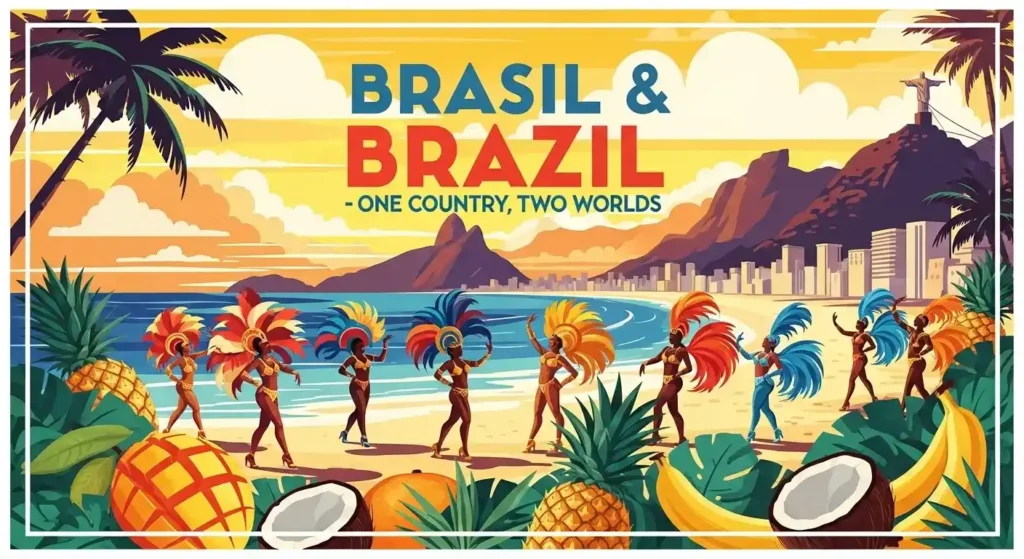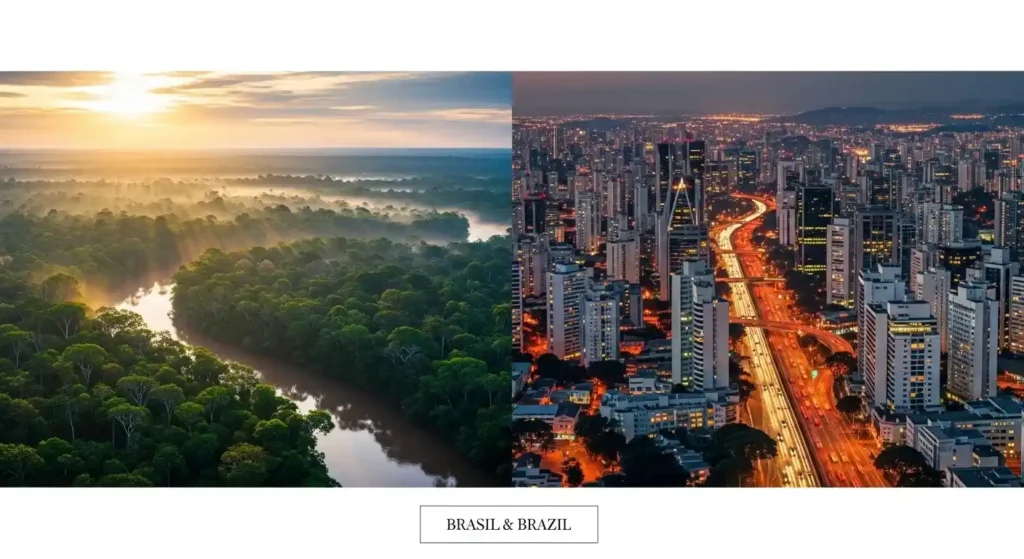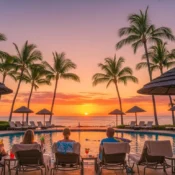
Brasil & Brazil – Culture, Travel, and Differences
Brazil is a vibrant country in South America that is known all over the world. It has two different spellings that often confuse travelers and language lovers: Brasil & Brazil. Although both spellings refer to the same magnificent country, each one has its own unique story rooted in linguistic heritage and cultural identity.
Both names come from the legendary pau-brasil wood, a crimson-red timber that captivated early Portuguese colonizers in the 16th century. This precious dyewood became so synonymous with the territory that it eventually lent its name to the entire nation. The country name difference comes from linguistic traditions: Brasil is the authentic Portuguese spelling used within the nation and throughout Portuguese-speaking communities, while Brazil is the internationally recognized English variant.
The pronunciation differs subtly yet meaningfully—Brasil has an unvoiced “s” sound, while Brazil has a voiced “z” that rolls off English-speaking tongues with familiar ease.
This interesting duality goes beyond just spelling rules. Brazilian culture is a rich blend of indigenous traditions, African heritage, European influences, and contributions from immigrants across five different regions. Each area has its own unique experiences that define this extraordinary nation, from the mystical festivals of the Amazon to the lively rhythms of Rio’s Carnival.
You can learn more about how regional diversity shapes local celebrations, discover the UNESCO-recognized art of Samba, and find important travel tips for experiencing authentic Brazilian culture at Epicurean Stay.
Table of Contents
Understanding the Name: Brasil vs. Brazil

The debate over whether to use “Brasil” or “Brazil” as the correct spelling of the country’s name comes from centuries of language evolution and colonial history.
Historical Background of Name Variations
When Portuguese explorers first discovered a valuable red dyewood called pau-brasil in the early 1500s, they named their new territory after this precious resource. The official name “Brasil” was established by Portuguese colonizers in their administrative documents and maps from 1500 onwards. This spelling remained consistent throughout the colonial period and is still used today as the country’s official name in the Portuguese language.
Other European countries that began documenting this South American territory adapted the name to fit their own languages, resulting in variations like “Brazil.”
Linguistic Reasons for Spelling Differences
The change from “Brasil” to “Brazil” reflects key differences between Portuguese and English language structures:
- In Portuguese, the “s” in “Brasil” produces an unvoiced consonant sound, creating the pronunciation “Brah-ZEEL.”
- In English, the spelling “z” aligns with phonetic rules, producing a voiced “z” sound in “Brah-ZIL.”
- English has become the dominant language for international trade and diplomacy, spreading the “Brazil” spelling worldwide.
Modern Usage Patterns
Each version of the name serves specific linguistic communities:
- “Brasil” is used in Portuguese-speaking contexts, official government documents, and within South American diplomatic relations.
- “Brazil” is primarily used in international media, English-language publications, and global tourism materials.
These differences in pronunciation go beyond just how the words are spelled. Portuguese speakers emphasize the final syllable with a longer vowel sound, while English speakers typically stress the first syllable with a shorter, more clipped delivery.
Understanding these linguistic subtleties can enhance your cultural appreciation when planning your trip through this magnificent country.
Cultural Diversity Across Brazil’s Regions

Brazil is a country with a rich cultural heritage, and its diverse regions each have their own unique traditions that have developed over centuries through a blend of different cultures. These regional traditions are expressed through vibrant festivals, delicious food, and various forms of art, all of which highlight the significant influence of indigenous peoples and immigrant communities on Brazilian culture.
North Brazil: Indigenous Roots and Festive Traditions
In the northern part of Brazil, particularly in the Amazon region, you can find some of the country’s most genuine cultural practices. Here, indigenous heritage coexists with influences from colonial times and modern society. The cultural identity of this region comes alive through grand celebrations that pay tribute to both spiritual beliefs and communal connections.
Festa do Boi-Bumbá: A Theatrical Celebration
One of the most captivating festivals in North Brazil is Festa do Boi-Bumbá, especially in Parintins, Amazonas. During this theatrical celebration, the entire city transforms into a stage where two rival groups—Garantido and Caprichoso—compete against each other by showcasing elaborate performances. These performances feature:
- Colorful costumes inspired by Amazonian wildlife and folklore
- Traditional music blending indigenous rhythms with Portuguese melodies
- Dramatic storytelling centered around the legend of a resurrected ox
- Community participation involving thousands of performers and spectators
The roots of this festival can be traced back to indigenous cattle-raising traditions mixed with Portuguese colonial influences. As a result, it has become a distinctive cultural expression that UNESCO recognizes for its artistic significance.
Círio de Nazaré: A Religious Procession
Another important aspect of northern Brazilian culture is represented by Círio de Nazaré, which takes place in Belém, Pará every October. This religious procession draws over two million devotees who come to honor Our Lady of Nazareth through various activities such as:
- Pulling a decorated carriage as part of a massive rope procession
- Selling traditional foods by street vendors throughout the celebration
- Displaying regional crafts in markets surrounding the event
- Featuring local artists and traditional songs during musical performances
What makes this event unique is how it showcases the adaptation of Catholic traditions to local customs. By incorporating indigenous elements and regional flavors into its rituals, Círio de Nazaré stands apart from similar celebrations found elsewhere in Brazil.
Folia de Reis: Extending Christmas Celebrations
Another significant cultural practice in North Brazil is Folia de Reis, which extends Christmas festivities well into January. During this time, traveling musical groups visit homes and communities to perform sacred songs that blend Portuguese religious themes with local melodies. Additionally, they also present theatrical depictions portraying the journey undertaken by the Three Wise Men.
These various cultural expressions found throughout North Brazil highlight not only the importance placed on preserving indigenous heritage but also how different influences have shaped these traditions over time.
Northeast Brazil: African Heritage and Vibrant Celebrations

The Northeast region is the heart of Afro-Brazilian culture, where centuries of African heritage have become an integral part of everyday life. This cultural powerhouse emerged from the forced migration of millions of enslaved Africans, who brought with them rich traditions that would fundamentally transform Brazilian identity.
Candomblé: A Spiritual Fusion
Candomblé, the syncretic religion born from Yoruba, Bantu, and Fon spiritual practices, remains deeply embedded in Northeast Brazil culture. Sacred rituals honor orixás (deities) through elaborate ceremonies featuring drumming, dancing, and offerings. These religious practices influenced everything from culinary traditions to artistic expression, creating a unique spiritual landscape that continues to thrive today.
Music and Dance: Echoes of Africa
The region’s musical DNA carries unmistakable African rhythms. Samba origins trace directly to this area, where enslaved communities developed complex percussion patterns and call-and-response vocals. Traditional dances like Caboclinhos and Ciranda showcase the intricate footwork and communal spirit inherited from African ancestors.
Carnival: A Spectacle of Afro-Brazilian Culture
Carnival reaches its most spectacular heights across northeastern cities, transforming streets into explosive celebrations of Afro-Brazilian music and dance. Salvador’s Carnival, in particular, features massive blocos (street parties) where millions participate in synchronized dancing to axé music, frevo, and other regional rhythms.
Culinary Delights: Flavors of Africa
The culinary landscape reflects this African influence through dishes like Acarajé – deep-fried black-eyed pea fritters served with spicy sauces – and Vatapá, a creamy mixture of bread, shrimp, and palm oil. These foods, originally prepared for Candomblé ceremonies, have become beloved regional specialties.
Travelers seeking authentic cultural immersion will find Epicurean Stay experiences that connect them with local communities preserving these ancient traditions through contemporary expressions.
Central/Western Brazil: Indigenous Influence and Immigrant Blend
The vast expanses of Central and Western Brazil showcase a unique cultural tapestry where indigenous traditions form the foundation of regional identity. Native peoples like the Xavante, Bororo, and Kayapó have preserved ancestral customs that continue to influence local arts, crafts, and spiritual practices. Their deep connection to the land manifests in traditional pottery techniques, intricate beadwork, and ceremonial dances that celebrate the cycles of nature.
This indigenous foundation blends seamlessly with waves of immigrant cultures that arrived throughout the 19th and 20th centuries. German, Italian, and Japanese communities established themselves across the region, bringing distinctive architectural styles, culinary traditions, and agricultural techniques. The result creates a fascinating cultural mosaic where traditional indigenous festivals incorporate European musical instruments and immigrant cooking methods adapt to local ingredients.
Cultural Fusion in Festivals
Festa do Divino stands as the region’s most celebrated religious festival, demonstrating this cultural fusion perfectly. The celebration combines Catholic devotion brought by Portuguese colonizers with indigenous ceremonial elements and immigrant community participation. During the festival, elaborate processions wind through towns decorated with colorful banners, while traditional foods like arroz com pequi and pamonha are shared among participants.
The Cavalhada festival further exemplifies Central Brazil’s multicultural heritage, featuring theatrical performances that reenact medieval European battles while incorporating indigenous storytelling techniques. These celebrations create spaces where different cultural groups maintain their distinct identities while contributing to a shared regional culture.
Culinary Diversity
Local cuisine reflects this diversity through dishes that combine indigenous ingredients like pequi fruit and mandioca with European cooking methods and immigrant spices, creating flavors unique to Central Brazil’s cultural landscape.
Southeast Brazil: Urban Culture and Carnival Spectacle

Southeast Brazil is the country’s economic powerhouse, where metropolitan sophistication meets explosive cultural celebrations. This region showcases how Brazilian culture has evolved within urban environments while maintaining its deep-rooted traditions and multicultural identity.
The Spectacle of Carnival
Rio de Janeiro’s Carnival is the world’s most spectacular cultural event, transforming the city into a vibrant stage where brasil & brazil showcase their finest artistic expressions. The famous Sambadrome becomes the epicenter of this global phenomenon, where elaborate floats, stunning costumes, and thousands of dancers create an unforgettable spectacle that attracts millions of visitors annually. This celebration perfectly embodies the fusion of indigenous influence, African rhythms, and European pageantry that defines the nation’s identity.
Regional Traditions in Urban Landscapes
The region’s urban landscape pulses with diverse regional traditions that reflect centuries of cultural blending. São Paulo’s neighborhoods celebrate their immigrant cultures through festivals honoring Italian, Japanese, and Lebanese communities, while maintaining strong connections to African and indigenous heritage. These celebrations demonstrate how Southeast Brazil tourism offers visitors authentic experiences beyond the famous beaches and landmarks.
Year-Round Cultural Events
Cultural venues throughout the region host year-round events celebrating the multicultural makeup inherited from Portuguese colonizers, African slaves, and various immigrant groups. From intimate samba circles in Rio’s neighborhoods to grand theatrical performances in São Paulo’s cultural centers, the Southeast provides countless opportunities to experience authentic Brazilian artistry.
Culinary Diversity
The region’s culinary scene reflects this cultural diversity, with traditional dishes like feijoada sharing space with innovative fusion cuisine that honors the area’s cosmopolitan character. Visitors exploring epicureanstay.com can discover accommodations that provide easy access to these rich cultural experiences while enjoying the comfort of modern urban amenities.
South Brazil: European Influences and Unique Traditions
The southern states of Rio Grande do Sul, Santa Catarina, and Paraná showcase Brazil’s most pronounced European character, where waves of immigration created distinct cultural landscapes that set this region apart from the rest of the country. Portuguese settlers established the foundation, but subsequent arrivals of Spanish, Italian, and German communities transformed South Brazil into a mosaic of European immigrants traditions.
Italian Heritage
Italian heritage dominates many communities, particularly in Rio Grande do Sul’s Serra Gaúcha region. The Festa da Uva in Caxias do Sul celebrates this connection through:
- Traditional grape stomping ceremonies
- Authentic Italian cuisine prepared by descendants of original settlers
- Folk dances performed in period costumes
- Local wine tastings featuring varieties brought from Italy
German Influences
German influences shine brightest in Santa Catarina’s Blumenau, where the famous Oktoberfest rivals its Bavarian counterpart. This celebration features traditional German beer, bratwurst, and folk music performed by local bands wearing lederhosen and dirndls.
Gaucho Culture
The gaucho culture of Rio Grande do Sul blends Portuguese and Spanish regional traditions with unique local customs. Cowboys on horseback demonstrate traditional skills while preparing churrasco (barbecue) and sharing chimarrão (mate tea) in ceremonial gourds passed among friends.
Architectural Contributions
South Brazil European immigrants also contributed architectural styles visible in colonial towns like Gramado and Canela, where Alpine-inspired buildings house chocolate shops and artisan breweries. These communities maintain their ancestral languages alongside Portuguese, creating a multilingual environment that reflects the region’s complex multicultural makeup.
Celebrating Diversity
The region’s festivals celebrate this diversity through events like the Pomeranian Festival in Santa Catarina and various Polish celebrations throughout Paraná, each maintaining authentic traditions while adapting to Brazilian culture.
Samba – The Heartbeat of Brazilian Culture

Samba is more than just a dance; it’s the very essence of Brazilian culture. Its infectious rhythm resonates in every corner of Brazil, making it the country’s most recognizable form of artistic expression.
The Origins of Samba
Samba’s roots can be traced back to the 19th century when African slaves and European musical influences came together in Brazil. This fusion gave birth to a dynamic dance style that became a powerful representation of Brazilian identity, transcending social and economic barriers.
African Influence
African slaves brought their rich musical heritage to Brazil, including:
- Ancestral rhythms
- Percussion instruments
- Circular dance movements
European Influence
In Brazil, these African traditions encountered European musical elements such as:
- Harmonic structures
- Melodic patterns
This blending of cultures resulted in a one-of-a-kind art form that encapsulated the resilience, joy, and spirit of Brazil’s diverse population.
Samba as Cultural Resistance
For enslaved individuals, Samba was more than just entertainment; it was a means of cultural resistance and community bonding. Through this dance, they could:
- Preserve connections to their heritage
- Adapt to their new environment
- Foster solidarity among their peers
UNESCO Recognition
The significance of Samba extends beyond its historical context. In recognition of its cultural importance, UNESCO has designated Samba as an Intangible Cultural Heritage of Humanity. This esteemed title acknowledges Samba’s contributions to:
- Preserving traditional knowledge
- Promoting social unity
- Sustaining cultural diversity across generations
The Richness of Samba Dance Styles
Brazil’s regional diversity is beautifully reflected in the various styles of Samba dance:
- Samba de Roda: Traditional folk dance performed in circles, emphasizing community participation
- Samba Enredo: Theatrical parade music that tells stories during Carnival celebrations
- Samba-Canção: Romantic ballad style that emerged in urban settings
- Partido Alto: Improvisational form featuring complex African drum rhythms
- Pagode: Contemporary evolution focusing on intimate gatherings and storytelling
Each style possesses its own unique qualities, ranging from the spiritual aspects found in Samba de Roda to the extravagant choreography showcased during Carnival parades.
Samba as a Living Museum
The dance itself acts as a living museum, preserving Brazil’s history through movement, music, and community involvement. It encapsulates tales of struggle, celebration, and cultural growth—stories that continue to shape the nation’s identity today.
Modern Samba and Authentic Experiences
While honoring its origins, modern Samba remains adaptable and open to evolution. This makes it an ideal choice for travelers seeking genuine cultural experiences across Brazil.
Whether you’re exploring vibrant cities or remote towns, you can immerse yourself in the world of Samba by visiting Epicurean Stay destinations throughout the country. Here are some examples:
- Rio de Janeiro: Experience the electrifying atmosphere of Carnival and witness grand parades showcasing elaborate floats and samba schools.
- Salvador Bahia: Discover the roots of samba through traditional performances at local festivals and street parties.
- São Paulo: Dive into urban samba scenes with live music venues where talented artists showcase their skills.
By engaging with these authentic encounters, you’ll gain deeper insights into Brazil’s rich cultural tapestry while supporting local communities along the way.
Travel Tips for Experiencing Brazil’s Culture

Planning your travel to Brazil tips requires strategic timing to witness the country’s most spectacular cultural experiences Brazil regions offer. Each region celebrates its heritage through distinct festivals that showcase the authentic spirit of brasil & brazil.
Festival Calendar by Region
Here are some key festivals and cultural events happening in different regions of Brazil throughout the year:
North Brazil
- June: Festa do Boi-Bumbá in Parintins
- October: Círio de Nazaré pilgrimage in Belém
- May to September: Ideal weather for exploring Amazonian cultural traditions
Northeast Brazil
- February/March: Carnival season with Salvador’s street parties
- June: Festas Juninas celebrating rural traditions across the region
Central/Western Brazil
- May: Festa do Divino celebrations showcasing indigenous heritage
- April to September: Comfortable exploration of Pantanal communities during the dry season
Southeast Brazil
- Rio’s world-famous Carnival dominates the cultural calendar
- Smaller celebrations throughout the year provide intimate experiences
- July/August: Paraty’s literary festival combining culture with pleasant winter weather
South Brazil
- October: Oktoberfest in Blumenau celebrating European heritage
- February/March: Festa da Uva in Caxias do Sul with mild temperatures enhancing the festive atmosphere
Cultural Immersion Strategies
Here are some strategies you can use to immerse yourself in Brazilian culture:
- Visit local music venues called casas de show for authentic samba experiences beyond tourist performances.
- Participate in community rodas de samba (samba circles) to engage in genuine cultural exchange with Brazilian musicians and dancers.
- Join regional dance schools for lessons in traditional styles like forró in the Northeast or carimbó in the North, connecting directly with local communities while learning cultural expressions passed down through generations.
- Consider staying with families through platforms featured on Epicurean Stay, where cultural exchange happens naturally through shared meals and daily interactions for deeper immersion.
Conclusion
Brasil & Brazil is a country with diverse cultures, where each region has its own unique traditions that come together to create a beautiful cultural blend. From the festivals influenced by indigenous cultures in the North to the traditions shaped by European immigrants in the South, this nation offers a rich tapestry of human expression.
Regardless of how you spell it, Brasil or Brazil, this South American gem invites travelers to go beyond typical tourist experiences and immerse themselves in authentic cultural encounters. Dance to the infectious rhythms of samba in Rio’s streets, witness the spiritual devotion of Círio de Nazaré in Belém, or savor traditional chimarrão with locals in the South.
The cultural richness Brazil offers extends far beyond its famous beaches and landmarks. Each festival, each dance, each regional dish tells the story of a people who have transformed centuries of diverse influences into something uniquely Brazilian. The warmth of its people matches the vibrancy of their traditions, creating connections that transcend language barriers.
For those seeking genuine travel inspiration South America can provide, Brazil stands as a testament to the beauty of cultural fusion. Pack your curiosity, bring your sense of adventure, and prepare to discover why this nation captivates hearts worldwide. Your Brazilian cultural journey awaits, promising memories that will resonate long after you return home.
Ready to explore Brazil’s cultural wonders? Start planning your authentic Brazilian experience at Epicurean Stay.
FAQs (Frequently Asked Questions)
What is the difference between the names Brasil and Brazil?
The dual spelling of Brasil and Brazil originates from the pau-brasil wood, with ‘Brasil’ used in Portuguese and ‘Brazil’ in English. The variation reflects linguistic differences and pronunciation unique to each language.
How does Brazil’s cultural diversity vary across its regions?
Brazil’s cultural diversity is shaped by indigenous peoples, Portuguese colonizers, African slaves, and various immigrant groups. Each region—from North Brazil’s indigenous festivals like Festa do Boi-Bumbá, to Northeast Brazil’s Afro-Brazilian music and Carnival, Central/Western Brazil’s indigenous influences and immigrant blends, Southeast Brazil’s urban culture and Rio Carnival, to South Brazil’s European heritage—showcases unique traditions and customs.
What are some major festivals celebrated in North Brazil?
North Brazil celebrates vibrant festivals such as Festa do Boi-Bumbá and Círio de Nazaré, alongside cultural expressions like Folia de Reis, highlighting the region’s rich indigenous roots and festive traditions.
Why is Samba considered the heartbeat of Brazilian culture?
Samba originated among African slaves blending with European forms, becoming a symbol of Brazilian identity. Recognized by UNESCO as an Intangible Cultural Heritage, Samba embodies the spirit and rhythm central to Brazil’s cultural expression.
When is the best time to visit Brazil to experience its cultural festivals?
The best times to visit Brazil align with major regional festivals such as Carnaval in the Northeast and Southeast regions, Festa do Boi-Bumbá in North Brazil, and Festa do Divino in Central Brazil. Planning travel around these events offers immersive cultural experiences.
How have European immigrants influenced South Brazil’s culture?
South Brazil exhibits strong European influences from Portuguese, Spanish, and Italian immigrants. This heritage shapes unique traditions distinct from other Brazilian regions, contributing to the country’s rich multicultural tapestry.



